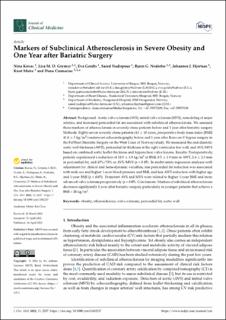Markers of Subclinical Atherosclerosis in Severe Obesity and One Year after Bariatric Surgery
Kovac, Nina; Grymyr, Lisa Marie Dale; Gerdts, Eva; Nadirpour, Saied; Nedrebø, Bjørn Gunnar; Hjertaas, Johannes Just; Matre, Knut; Cramariuc, Dana
Journal article, Peer reviewed
Published version

View/
Date
2022Metadata
Show full item recordCollections
- Department of Clinical Science [2318]
- Registrations from Cristin [9791]
Abstract
Background: Aortic valve sclerosis (AVS), mitral valve sclerosis (MVS), remodeling of major arteries, and increased pericardial fat are associated with subclinical atherosclerosis. We assessed these markers of atherosclerosis in severely obese patients before and 1 year after bariatric surgery. Methods: Eighty-seven severely obese patients (43 ± 10 years, preoperative body mass index [BMI] 41.8 ± 5 kg/m2) underwent echocardiography before and 1 year after Roux-en-Y bypass surgery in the FatWest (Bariatric Surgery on the West Coast of Norway) study. We measured the end-diastolic aortic wall thickness (AWT), pericardial fat thickness at the right ventricular free wall, and AVS/MVS based on combined aortic leaflet thickness and hyperechoic valve lesions. Results: Postoperatively, patients experienced a reduction of 12.9 ± 3.9 kg/m2 in BMI, 0.5 ± 1.9 mm in AWT, 2.6 ± 2.3 mm in pericardial fat, and 45%/53% in AVS/MVS (p < 0.05). In multivariate regression analyses with adjustment for clinical and hemodynamic variables, less pericardial fat reduction was associated with male sex and higher 1-year blood pressure and BMI, and less AWT-reduction with higher age and 1-year BMI (p < 0.05). Persistent AVS and MVS were related to higher 1-year BMI and more advanced valve sclerosis preoperatively (p < 0.05). Conclusions: Markers of subclinical atherosclerosis decreases significantly 1 year after bariatric surgery, particularly in younger patients that achieve a BMI < 28 kg/m2.
